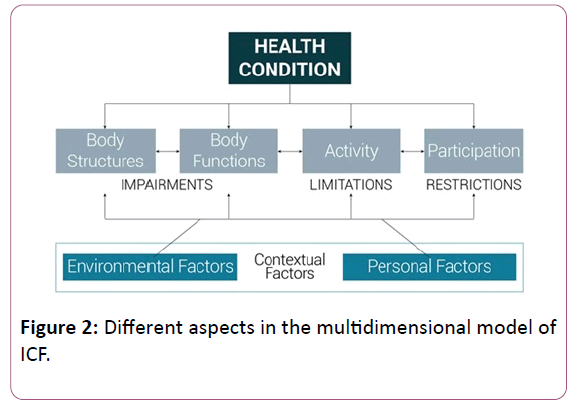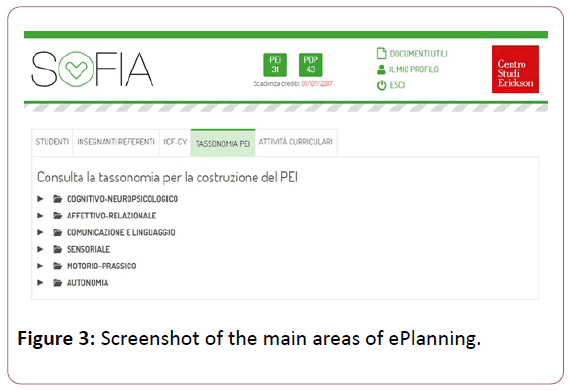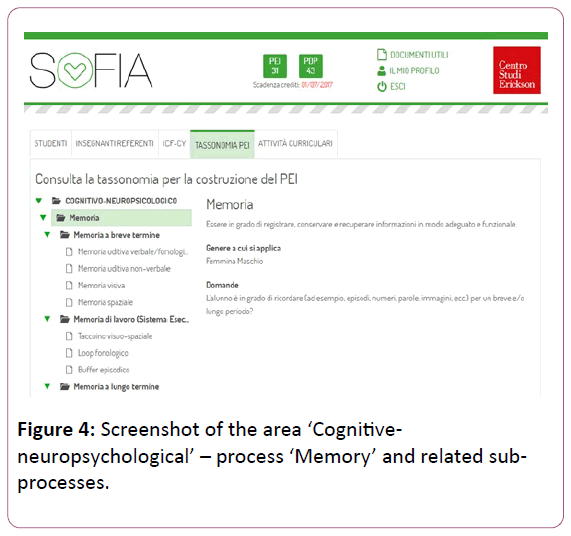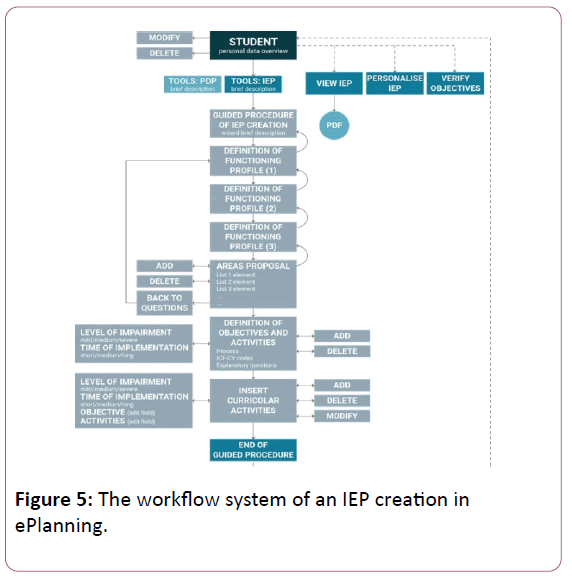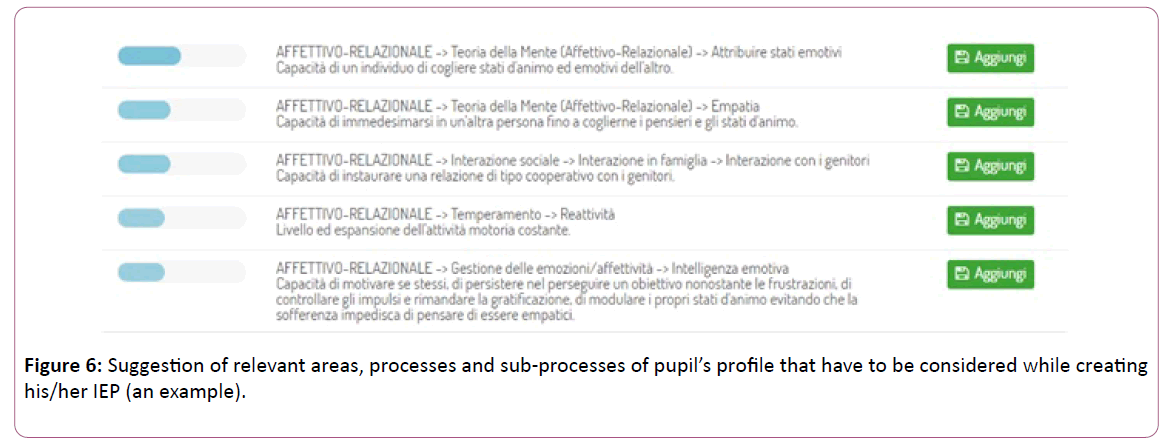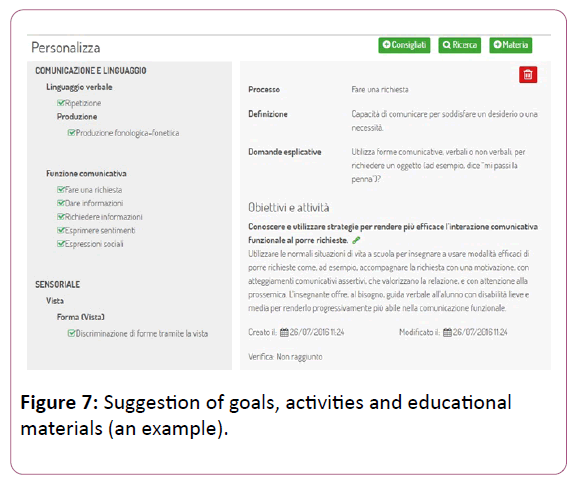Drafting the Individualized Education Plan for Students with Special Educational Needs: How Semantic Web Technology Can Help the Teachers
Angela Cattoni, Sofia Cramerotti and Dario Ianes
DOI10.4172/2472-1786.100060
Angela Cattoni1*, Sofia Cramerotti1 and Dario Ianes2
1Edizioni Centro Studi Erickson, Trento, Italy
2Free University of Bozen, Bolzano, Italy
- *Corresponding Author:
- Angela Cattoni
Edizioni Centro Studi Erickson
Trento, Italy
Tel: +46736637601
E-mail: angela.cattoni@erickson.it
Received Date: October 14, 2017; Accepted Date: October 25, 2017; Published Date: October 30, 2017
Citation: Cattoni A, Cramerotti S, Ianes D (2017) Drafting the Individualized Education Plan for Students with Special Educational Needs: How Semantic Web Technology Can Help the Teachers. J Child Dev Disord. 3:22. doi: 10.4172/2472-1786.100059
Abstract
One major issue emerges out of general observations and consensus in Italy and it concerns the knowledge and assessment of the students with disabilities and Special Educational Needs (SEN). Related to this issue, there is an increasing attention for a specific need: making an accurate assessment of the disabled students’ strengths and weaknesses and, on this basis, building an Individualized Educational Plan (IEP) that can really meet their actual characteristics and needs. Our paper presents the results of a two years’ research project aimed at adopting semantic web technology to draft the IEP for pupils with Special Educational Needs on the basis of WHO’s International Classification of Functioning, Disability and Health (ICF). This innovative model allows to understand, describe and share pupil’s functioning. It could be positively used by school professionals and health professionals at an international level and it gives the opportunity to use a bio-psycho-social conceptualization of health and functioning.
Keywords
Individualized education plan; Special educational needs; Semantic web technology; Ontology-based decision support system; ICF model
The Integration and Inclusion of Students with Disabilities and Special Educational Needs (SEN)
The daily reality of our schools, as well as that of our society, is characterized by constant confrontation with the heterogeneity of our students’ needs. Seventeen years ago, Brahm Norwich theorised the co-existence, within the school context, of three basic types of educational needs [1]:
1. Common needs, which refer to characteristics possessed by all;
2. Specific needs, covering aspects shared by some pupils;
3. Individual needs, which refer solely to some pupils and that are different from everything else.
In the year 1977, Italy, one of the first few nations in the world, promoted a full inclusion model with a specific law. For forty years, the Italian school has welcomed all pupils with disabilities in general classes.
According to the Framework Law passed in 1992 (no. 104/92), the aim of integration in schools is to develop the learning of students with disabilities and their communication and social skills and to ensure that they have access to individualised learning, within mainstream schools, and the necessary resources in order to achieve it.
The statement of disability that is issued by the Italian health service plays a central role in this process. It is based on the medical definition of a person with disability as ‘person suffering from any physical, mental or sensorial impairment, whether stable or progressive, that causes difficulties with learning, relationships or integration in the workplace, to the extent that it leads to social disadvantage or marginalisation’ (Framework Law 104/1992). Only statemented students are entitled to follow an Individual Education Plan (IEP) and to be placed in a class that, in addition to the class teacher, has a support teacher assigned to it.
In recent years, the Italian school has contributed to innovate the laws, in search for an answer to the educational needs of pupils with Specific Learning Disabilities (SLD) and other forms of socio-cultural, linguistic or clinic disadvantage. Therefore, all the normal and special educational needs, that require specific educational measures to achieve full inclusion of all pupils, converge in the macro category of Educational Needs. The inclusion results in the highest possible degree of learning in relation to pupils’ potential and participation in social and community life.
The concept of Special Educational Needs (SEN) appeared in official documents of UNESCO in 1997, in the United Kingdom legislation in 2001 (Special Educational Needs and Disability Act) and in the documents of the European Agency for Development of Education for Special Needs in 2003, as a tendency to consider as SEN people also children who experience learning and behaviour difficulties that are different from disability.
On this basis, in 2005 Ianes proposed a different meaning to the concept of SEN: not an extensive collection of numerous clinical diagnosis, but an open, dynamic and even transient possibility to collect all the problematic functioning situations which hinder an individual in getting satisfactory answers to their needs [2,3].
In this way, in order to understand a SEN situation, we do not need clinical diagnosis, but observation and evaluation of the real interactions between several factors. Only then we can determine whether a particular functioning is really problematic for that specific individual. And if that specific person does actually experience a problematic situation, according to three objective criteria – damage, obstruction and social stigma – we should activate a ‘special’ intervention in order to better satisfy his/her needs.
Unlike most other clinical conditions, this situation of Special Educational Needs may be quite transitory, if we change the conditions that originated it.
Therefore, the concept of SEN is not clinical, but it derives from a need for equity in the recognition, by school and welfare systems, of the various functioning situations which should be enriched with special and individualised interventions Figure 1.
The Individualized Education Plan (IEP)
The conditions that cause learning disabilities and Special Educational Needs are many: some are severe and well-defined (i.e. intellectual disability), others may not be. Faced with these objective difficulties, teachers need to develop forms of individualized teaching. In general, this means defining goals, educational attitudes and activities specifically designed for individual peculiarities, and paying particular attention to each student’s strengths and weaknesses.
The Framework Law sets out the documents that form the basis of individualised learning, that are:
Functional diagnosis. This is a diagnosis written by a team of professionals from the health and social services that describes the strengths and weaknesses of students with disabilities.
Dynamic functional profile. This document is drafted by a team of social and healthcare professionals together with the student’s teachers and family. It outlines attainable development objectives for the student and is generally reviewed each time the student progresses from one school stage to another.
Individualized Education Plan. This is also written by a team of social and healthcare professionals together with the student’s teachers and family. It sets out the student’s goals and the methods and resources that will be used to achieve them, generally within the timeframe of one school year.
In order to achieve full inclusion. within regular classes of the public school, of all the students with Special Educational Needs, the Italian Law 104/1992 requires an Individualized Education Plan (IEP) for students certified for a disability.
The IEP defines academic/life goals, methods and educational intervention (activities, supports and services) in order to achieve the defined objectives (on a long/medium/ short term range) and it is the result of a collaborative effort that involves the school special education team, the teachers, the parents, other relevant educational and medical stakeholders, as well as, whenever possible, the student [4-6].
The first part of an IEP is the functional diagnosis, which differs from the clinical, nosographic and aetiological diagnoses. Health service is primarily responsible for this diagnosis, which should identify and describe in detail the subject’s cognitive, educational and psychological functioning. In the law-makers’ purposes, this diagnosis was meant to involve and engage all the school educational and psychological components, including teachers in their everyday inclusion practices.
However, many problems have emerged and have been discussed to this regard, especially after 1994, when the law assigning the task of making the functional diagnosis to public healthcare was issued. More specifically, the problems that emerged, and that are still present, relate to the different cultural and professional perspectives of health professionals on one hand, and school professionals on the other hand. The strict medical model has often collided with the educational model; too much has been devolved on public healthcare, with the school expecting diagnoses which would miraculously guide teachers in their daily practice, but many health professionals are not capable of making an adequate assessment. Nonetheless, many teachers have used this expectation as a pretext to avoid engaging and devoting effort. Additional difficulties are related to staff shortages and the families not being involved in the evaluation process.
Toward a bio-psycho-social well-being definition
So, functional diagnosis – as a specific evaluation of the child aiming at his/her full school inclusion – is faced with some difficulties in Italy. However, there have been some positive changes with the introduction of World Health Organization’s ICF, the International Classification of Functioning, Disability and Health [7] as a stimulus to evolve functional diagnosis. The system was indeed welcomed by the school professionals and by those health professionals who are more sensitive to a comprehensive bio-psycho-social conceptualization of health and functioning.
The World Health Organization (WHO) has long conceptualized that health cannot be seen as a mere absence of illness, but it has to be conceived and primarily pursued as a bio-psycho-social well-being, that is the full realization of an individual’s potential in the various contexts of their life. This dynamic and context-related conception is in tune with the latest philosophical elaborations on the issues of justice and equity as supported by [7], as well as with the definition of ‘disability’ of the UN Convention on the Rights of Persons with Disabilities in 2006.
The framework of the ICF is a global, systemic and multidimensional vision of the individual which allows to understand and define different levels of functioning of a person and objectives about their skills development. This innovative model also recognizes the body, in its functions and structures – both anatomical and physiological – a key role and a continuous reciprocal interaction with personal activities, social participation and contextual factors, both environmental and personal, in order to plan a life project, helping not only the educational but also the social inclusion.
As Figure 2 illustrates, in this multidimensional model all components are important and interact reciprocally. Each component contains hierarchically arranged domains which, in turn, are sets of related physiological functions, anatomical structures, actions, tasks, areas of life, and external influences [7].
The ICF model fostered the evolution and improvement of functional diagnosis, making it actually more functional and directly relevant to school inclusion processes. Since health professionals have to consider and examine relationships among bodily, structural and functional dimensions, personal activity areas, environmental and personal (psychological, motivational, emotional) factors, in order to enhance social participation in both school and community roles, they cannot avoid involving and engaging teachers and families in the functional diagnosis process.
Increasingly spreading as a shared ground between public healthcare and school systems, this model provides a good basis to other significant improvements of inclusion in Italy. We are referring to the development of the Individualized Educational Plan into a ‘Life Project’, a life-long learning perspective looking to professional and social inclusion. The definition of learning and development goals related to adult life, in order to provide all the skills needed in adulthood, is increasingly common in Italy.
According to this trend, Italian school forwards inclusion and Individualized Education Plans while considering three main focuses of attention:
The child’s basic need to develop competence in the areas that ICF labels as ‘personal activities’ (learning, communication, interactions), as well as in the areas of cognition and metacognition, as far as possible;
The need to design individualized objectives, considering the child’s social participation in terms of being a pupil who, together with peers, takes part to shared activities in an active and significant manner. This second focus of attention aims at identifying curricular goals which are appropriate with respect to child’s abilities and deficits and to specific regular instruction courses; this is a major component of full and good-quality school inclusion;
The need of a wide and far-sighted perspective on the pupil’s life project, defining significant objectives in the areas of adult competence that are deeply interwoven with objectives related to the development of adult identity, including motivation, goals, self-efficacy, self-esteem, etc. To this respect, another critical component is the involvement of peers in the inclusion process.
A model in 7 key steps to improve inclusion
Along with our Research and Development department, we identified seven key points – the first of which is precisely represented by peers and classmates – for an inclusive education, seven dimensions of the teaching process on which the teacher can act in order to increase the inclusion levels within the class.
These seven dimensions are not specific measures addressed to pupils with SEN, but they are really inclusive educational measures, aimed at improving the learning conditions for all pupils. The teacher can actually improve inclusion by acting primarily on normality. Only by starting from this approach it will then be possible to activate special measures addressed to pupils with SEN, through the Individualized Educational Plans [8].
The seven key points are:
Peers and classmates – classmates are the most precious resource for activating inclusive processes. Pair work strategies and cooperative learning in small groups should be particularly valued. Peer tutoring and workshop teaching, based on active and meaningful participation of pupils in the lesson, is especially effective for students with SEN.
Adaptation and simplification of contents – giving value to individual differences means adapting materials according to the different levels of competence and the different cognitive styles of the students. The most functional type of adaptation is based upon materials which activate multiple channels of information processing and which facilitate access to and elaboration of contents, providing additional help and tasks with gradual complexity.
Logical and visual strategies (i.e. maps, diagrams and visual aids) – traditional teaching strategies are often and entirely based on written or oral coding. To foster inclusion, logicalvisual strategies should be stimulated, especially through the use of mind maps and conceptual maps. Of great help to pupils with SEN are also all kinds of schematisation and anticipated organisation of knowledge, such are diagrams, timelines, meaningful illustrations and flashcards.
Cognitive processes and learning styles – to ensure that all pupils are learning, the cognitive processes at the basis of learning itself have to be developed. It is particularly important to work on the specific functions of attention and on the phases and processes of long and short-term memory. It is just as important to develop problem solving abilities and divergent creative thinking and convergent thinking, including analysis and summary skills. In secondary school, basic cognitive processes are used in the metacognitive sphere (attention control, awareness of memory processes, etc.), although direct development is no longer practiced. The valorisation of different cognitive processes and learning styles thus become important.
Metacognition and study strategies – developing awareness in pupils of their own cognitive processes is the transversal aim of all teaching activities. The teacher operates on four levels of metacognitive action, in order to develop self-regulation and cognitive and emotional mediation strategies, and to structure a personalised and effective method of study, which is often lacking in pupils with difficulties.
Emotions and psychological variables – emotions play a key role in learning. It is thus paramount to develop a positive self-image, self-esteem and self-efficacy and a positive internal attributional style. Motivation to learn is strongly influenced by these factors, as emotions are related to peer and class group belonging.
Assessment, evaluation and feedback – from an inclusive point of view, test formats have to be personalised in the way that instructions are given and in the way that pupils should answer to them. Furthermore, the use of dispensation measures and compensatory tools should be encouraged, as by law. Assessment should develop metacognitive processes in the pupil and, therefore, feedback have to be continuous, instructive and motivating.
The development of ePlanning
The various difficulties faced by pupils with Special Educational Needs necessarily require a concrete answer from both educational and learning perspectives.
The drafting of the Individualized Education Plan for students with disabilities and that of the Personalized Didactic Plan (PDP) should not be considered as the fulfilment of a bureaucratic request set by specific laws, but as a moment of real educational planning related to the actual needs expressed by the pupils.
First of all, this means observing the pupils and their functioning, identifying objectives, activities and educational strategies and attitudes that suit the specific peculiarities of that pupil, paying particular attention to their strengths, from which to start to set work, and at the same time considering their weaknesses from which the educational work has to start.
The drafting of the IEP and its concrete application should never be delegated solely to the support teacher, involving at most some of their willing colleagues: all teachers should take part in it, because the inclusion process involves every aspect of school life and all individuals who work with the pupil.
It should be clarified that the situation of SEN is, in our opinion, the one in which general educational needs encounter great difficulty in finding adequate responses to a problematic bio-psycho-social functioning. If we adhere to the ICF anthropological model, we understand very well that the problems of global functioning can arise from biological factors (either in the body structures or functions), environmental context, personal factors, activity limitations and/or social participation. In any of these six domains, a cause of SEN can be generated, and it interacts systematically with other elements, which may be favourable (facilitators) or adverse (barriers) to the individual’s functioning.
In the analysis of functioning, the interaction between these six domains is very useful for educational purposes. It provides a non-static explanation of functioning, which is constantly redefined: the domains are related to each other and a little change in one aspect may lead to a greater change in the subject's functioning. Thus, ICF can be considered as a tool for identifying facilitators and barriers within the environmental and personal contexts of a person [9].
Despite the extensive and recent use of IEPs in several Italian schools of any educational level (kindergarten, primary school, middle school, high school), the development of an IEP for a specific pupil is a manual, complex and time-consuming activity for all the school stakeholders.
In order to facilitate the design of the IEP, we developed a web-based decision support system, called ePlanning. Users put information about relevant aspects of the pupil’s profile (i.e. age, diagnosis, observations about abilities and disabilities in student’s functioning, etc.) into the system and the system guides the users in defining appropriate goals and the most suitable activities and materials to achieve them.
This technological system shows a collaborative building of a high-quality ontology. In particular, a team composed by 20 users with different but complementary competences and skills has been involved during the development: psychologists, educators, teachers, knowledge engineers and application engineers.
Thanks to ePlanning, drafting an IEP is the result of a collaborative activity between teachers, health professionals, parents and, whenever possible, the student.
Semantic Web technology plays a key role in ePlanning, as well as in its development. ePlanning is an ontology-based application [10]: all the content, that the system uses in order to guide the construction of an IEP, is encoded in an OWL 2 ontology, which formalizes:
processes, that represent the functional abilities of the student;
relevant features of pupil profiles that have to be taken in consideration while designing an IEP (i.e. age, school grade, diagnosis in terms of ICD-10 or ICF-CY, the two main World Health Classifications), as well as the relationship between these aspects and functional abilities;
suggestion of goals that can be set in presence of an impairment of some functional abilities;
activities and educational materials that can be used to achieve the goals.
The first step in the work plan has been to precisely determine a conceptual framework as reference both for the definition of a psycho-pedagogical model and the system architecture, as well as the formalization of the knowledge base [11].
A conceptual framework: the psycho-pedagogical model
With regard to the definition of the psycho-pedagogical model, a group of experts carried out a careful analysis of the state of the art in the field of individualized educational planning, highlighting the models and methodologies most commonly used in the Italian territory.
They started from the definition and schematization of the processes underlying the creation of an IEP [2,3,5,6,12] and a PDP [4] as described in literature and practices currently used by schools.
Subsequently, the IEP model, proposed by Erickson since 1993 [5], was shared and used as framework of reference for the whole project.
In this model, the IEP consists of several components that correspond to as many planning and working phases:
Definition of the functional diagnosis through the functioning profile and skills/competences framework of the student;
Definition of the dynamic functional profile and of the working objectives.
Setting of activities and interventions aimed at achieving said objectives and identification of the most appropriate tools, methods, strategies and materials.
Constant monitoring of the efficacy of the educational plan. Fogarolo's proposal [4] was instead adopted as a PDP reference model.
System architecture and formalization of the knowledge base
As for the system architecture, the workgroup has elaborated several workflows for the realization of the system itself.
As already mentioned, we defined a reference ontology for the description of SEN students’ functioning profiles and a knowledge base that allows to store individualized educational planning strategies (the access to both the reference ontology and the knowledge base is granted through semantic queries).
The definition of the knowledge base was based, therefore, on what traditionally teachers accomplish during their educational activity, that is observing a pupil, identifying strengths (competences) and weaknesses (difficulties), defining suitable goals and structuring activities/functional interventions aimed at those goals.
There was a real formalization of the knowledge base accomplished by various ‘domain experts’, both as regard to the student's functioning profile and the set of goals and activities.
The formalization and the detection of a student's functioning profile are possible thanks to the definition of a taxonomy of processes and sub-processes (more than 400) and a pre-emptive questionnaire/checklist that guides the teacher in observing and assessing pupil's performance in the following areas:
Cognitive-neuropsychological
Affective-relational
Communication and language
Sensory
Motor-praxis
Autonomy (personal and social).
The formalization of learning objectives and didactic activities led to the creation of a database consisting of specific goals and activities for each school grade (more than 9000), differentiated on three levels of complexity (easy, medium, difficult) and related to the degree of deficit (mild, mean, severe) for each process/sub-process of the taxonomy (see the Appendix for an insight on the first two levels of each area of the taxonomy) Figures 3 and 4.
The drafting of the IEP is conducted by simple questions; answers are guided and collected on the basis of the taxonomy process and sub-processes, categorized with the corresponding ICF-CY classification entries through a semantic comparison (the comparison can be accessed within SOFIA itself), whenever it has been possible to find a match. SOFIA will therefore suggest the goals, differentiated by level of complexity, and the corresponding activities. The IEP will then be customizable by teachers on the basis of pupil’s observation within the school context. The software also contains a space dedicated to the definition of the disciplinary programme in line with ministerial guidance for the curriculum.
Figure 5 shows the workflow for the creation of an IEP in ePlanning, whereas Figures 6 and 7 respectively show a screen capture with the suggestions of relevant areas that have to be considered while creating the IEP and suggestions of goals, activities and educational materials.
The drafting of the PDP is also assisted and it allows a quick and precise process of the planning document [4].
The simplified and online-guided procedure allows to speed up the process of drafting and managing IEPs and PDPs, while the selection criteria remain extremely rigorous and scientifically based. The system also enables teachers to approach the use of ICF language, even for those who do not have an in-depth knowledge of the classification.
ePlanning functioning
As already explained in another article of ours [11], during each session of creation of an IEP, the system iteratively accesses the ontology by dynamically querying the content of the ontology according to the functional diagnosis of the pupil for whom the IEP has to be developed.
OWL-DL reasoning power is also exploited in this phase.
An important example of query is the one that returns all the information of a given functional ability. Given the Uniform Resource Identifier (URI) of a functional ability, the system connects to the data store containing the ontology, then it performs the query with SPARQL language and, at last, it retrieves all the relevant information.
Such information is both the ‘mother’ (the URI) and the ‘daughter’ of that functional ability (according to the taxonomy of processes and sub-processes), its label, description and clarifying questions in natural language, the sex compatible with that functional ability, some possible ICF-CY or ICD-10 codes, an order and a weight representing its relevance in the taxonomy.
Given the URI of a process representing a functional ability, another query is the one that returns the information of its sub-processes. First the query retrieves all the sub-processes, and then the query above is executed for extracting the information of every single functional ability. The power of the semantic technologies is that the URI of the individuals in the ontology univocally identifies them, so potentially (if the ontology was public) a single functional ability could be retrieved by whatever application in the world.
ePlanning architecture
The architecture of the ePlanning system is divided into three tiers:
the Presentation Tier;
the Business Logic Tier;
the Data Tier.
The Presentation Tier is the interface the user interacts with in order to create the IEP. It is the application oriented layer and it communicates its requests to the Business Logic Tier. The requests are handled by this second layer through methods exposed by a web service implemented with a REST (Representational State Transfer) architecture. Every method semantically queries the ontology from the Data Tier in order to satisfy the application logic. The Data Tier physically retrieves the data from the ontology with the logical inferences already computed.
The ontology is stored in an openRDF Sesame triple store.
ePlanning development team
In order to develop such a rich and complex ontology — process that was possible also thanks to the research partnership with the Data and Knowledge Management Unit of Trento 'Bruno Kessler' Foundation — a team of heterogeneous professionals (domain experts having complementary skills) was involved:
Psychologists, neuropsychologists and educators defined the taxonomy of processes and sub-processes referring to different functioning areas of the students; they also provided a glossary with the description of each item in the taxonomy. In order to bring teachers closer to the ICF classification and to foster the collaboration of different professionals (support and general teachers, educators, healthcare professionals, parents, etc.), the domain experts identified, whenever possible, a semantic comparison between ICF processes/subprocesses, domains/categories and ICD-10 alphanumeric codes.
Teachers (kindergarten, primary school, middle school, high school) defined the objectives (structured on three levels of complexity and for the short/medium/long term range) and related activities determined by the level of impairment.
Knowledge Engineers, with their modelling expertise, supported the domain experts during the ontology formalization.
Application Engineers helped during the application phases of modelling and implementation of the ontology.
The activities carried out by this heterogeneous group of professionals represent a good example of how an IEP team should work. All the members of an IEP team should, indeed, take part into a decision-making process based on sharing [13]:
Information, as each member uniquely contributes to the comprehensive understanding of the pupil’s individual needs through classroom observations, home experiences, relationships with peers and siblings, developmental stages, test results, and so on;
decision-making, as by sharing experiences, knowledge, concerns and resources, the probability of a wise decision and a positive synergism is much greater than when only one person decides and directs the others;
implementation, as each member will separately, but cohesively, act for the inclusion and the success of the pupil (i.e. the general classroom teacher will provide extra support and attention in order to keep the student with SEN in the general classroom; the special education teacher will work with the student one-to-one to help meet the goals that the team has set; the speech pathologist will help with the language component; the principal will coordinate and supervise all staff involved, the parents will support the student at home; etc.).
ePlanning modelling tools
As already stated [11], the modelling was performed with a customized version of MoKI, the Modelling Wiki, a collaboratively mediawiki-based tool which is generally used to model ontological and procedural knowledge [14,15].
The customization consisted in defining ad-hoc forms to guide users in contributing to the ontology, as well as in developing specific features to browse the ontology content.
The tool was extensively used by the modellers: in over a one-year modelling period, we tracked more than 6.500 editing operations.
During the development of the application and its ontology, certain aspects emerged:
Regarding the collaborative development, we remark the importance of having a flexible, ad-hoc, online, and collaborative modelling tool such as MoKI, which allowed us to avoid the proliferation of ‘latest versions’ of documents by domain experts, familiar with spreadsheet before this experience, and consequently considerably reducing the human effort.
During the modelling activities, also the early deployment of the application ontology in its corresponding system has been crucial. This favoured the improvement of the ontology quality and the early detection of modelling mistakes and assumptions.
The importance of adopting a hybrid ontological representation (i.e. representing each core element both as a class and as an individual) to ensure a multipurpose ontology, to be used as a traditional classification ontology on the one hand, and as the main data component of an application system on the other hand.
Regarding the application, in order to improve its rapid development, the access to the ontology was provided by a web-services exposing pre-canned SPARQL queries through API methods. The web service was implemented by the knowledge engineers, while the application engineers concentrated only on the application perspective without any efforts of interfacing with semantic data and without altering their usual development processes. This work methodology has allowed for a rapid development of the ePlanning system.
Conclusions
In September 2014, ePlanning has been released as a commercial tool, by the title of ‘SOFIA’ edited by Edizioni Centro Studi Erickson, aimed at the schools of all the national territory.
The SOFIA service helps primary and secondary school teachers (covering a group of pupils aged 3 to 18) with the draft of Individual Educational Plans (IEPs as by Law 104/92) and Personalized Learning Plans (PLPs as by Law 170/2010) which are fundamental tools for planning educational interventions that can be functional and actually close to the needs of pupils with disabilities and with Specific Learning Disorders (SLD).
The transition from a 'research project’ (ePlanning) to an ‘operative tool’ (SOFIA) has been crucial.
Since the release until May 2017, 5695 IEPs and 3173 PDPs have been created in SOFIA.
Implemented as part of the work the IEP team, SOFIA can contribute to a systemic, complete and functional plan for the success of the students with Special Educational Needs. whose complex needs cannot be addressed solely by the observations of teachers and of the school special educational team.
Through the appropriate use of such tools, the school special education teams may feel encouraged, supported and more comfortable in joining IEP teams and thus they can increase their expertise. In this way, they will be able to offer greater contributions to students with whom they are working every day in the school context and understand their needs more comprehensively, and furthermore students with SEN will directly benefit from these increased expertise and skills, as well as from the constructive collaboration of all the members of the IEP team.
We expect that our ePlanning research project and its editorial outcome, SOFIA, may benefit similar modelling initiatives, regarding the development of ontology-based applications in real contexts, in particular in the psychoeducational field.
Acknowledgements
This research project and work was partially funded and supported by «ePlanning – Sistema esperto per la creazione di progetti educativo-didattici per alunni con Bisogni Educativi Speciali», funded by the Operational Programme ‘Fondo Europeo di Sviluppo Regionale (FESR) 2007-2013’ of the Province of Trento, Italy.
The authors would like to thank the project partners Luciano Serafini, Marco Rospocher, Ivan Donadello and Elena Cardillo of the research unit Data and Knowledge Management, Fondazione Bruno Kessler, Trento (Italy) and all the members of the research team, particularly Desirèe Rossi, Giampiero Vaschetto, Giorgia Sanna, Marco Buccio, Massimo Turrini and Silvia Tabarelli.
References
- Norwich B (2000) Inclusion in education: from concepts, values and critique to practice. In Daniels H (eds.) Special Education Reformed: Beyond Rhetoric? London: Falmer Press.
- Ianes D (2004) Functional Diagnosis According to ICF. Trento: Erickson. Ianes D (2005) Special Educational Needs and Inclusion. Assess the real necessity and activate all the resources. Trento: Erickson.
- Ianes D, Macchia V (2008) Teaching for Special Educational Needs. Trento: Erickson.
- Fogarolo F (2014) Build Your Personalized Teaching Plan. Trento: Erickson.
- Ianes D, Cramerotti S (2009) The Individualized Educational Plan - Life Project, vol. 1: Methodology and working strategies; vol. 2: Collection of Materials, Tools and Teaching Activities, vol. 3: Collecting Good Practices of PEI Compiled and Commented. Trento: Erickson.
- Scataglini C, Cramerotti S, Ianes D (2008) Support in high schools. Trento: Erickson.
- Nussbaum M (2007) New frontiers of justice. Bologna: The Mill. OMS (2007) ICF-CY / International Classification of Functioning, Disability and Health - version for children and adolescents. Trento: Erickson.
- Research and Development Erickson (2015) BES at school. The 7 key points for inclusive education. Trento: Erickson.
- Ianes D, Demo H (2010) ICF. School Voices, IX, pp. 228-236.
- Rospocher M, Cardillo E, Donadello I, Serafini L (2014) On the collaborative development of application ontologies: a practical case study with a SME. In: Proceedings of the 19th International Conference on Knowledge Engineering and Knowledge Management (EKAW 2014), 24-28 November 2014, Linköping, Sweden.
- Cramerotti S, Ianes D (2016) An ontology-based system for building Individualized Education Plans for students with Special Educational Needs. Procedia – Social and Behavioural Sciences, 217, pp: 192-200.
- Cramerotti S (2010) Individualize educational programming: PEI based on ICF-CY. In: First National Conference on 'Integration and School Inclusion. Methodology, Tools and Practice », University of Bolzano, Bressanone, IT, 26 November 2010.
- Martin NRM (2005) A guide to collaboration for IEP teams. Baltimore: Brookes Publishing.
- Ghidini C, Rospocher M, Serafini L (2012) Modeling in a Wiki with MoKi: Reference Architecture, Implementation, and Usages. Inter J on Advances in Life Sci, IARIA, 4, pp. 111-124.
- Sen A (2010). L’idea di giustizia. Milano: Mondadori.
Open Access Journals
- Aquaculture & Veterinary Science
- Chemistry & Chemical Sciences
- Clinical Sciences
- Engineering
- General Science
- Genetics & Molecular Biology
- Health Care & Nursing
- Immunology & Microbiology
- Materials Science
- Mathematics & Physics
- Medical Sciences
- Neurology & Psychiatry
- Oncology & Cancer Science
- Pharmaceutical Sciences

